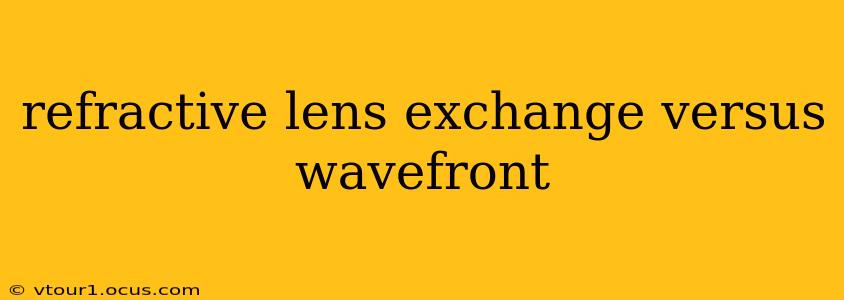Choosing between Refractive Lens Exchange (RLE) and Wavefront-Guided LASIK can feel overwhelming. Both procedures aim to correct refractive errors like nearsightedness (myopia), farsightedness (hyperopia), and astigmatism, but they differ significantly in their approach and suitability for various patients. This comprehensive guide will delve into the key differences, helping you make an informed decision.
What is Refractive Lens Exchange (RLE)?
RLE is a surgical procedure where your natural eye lens is replaced with an artificial intraocular lens (IOL). This IOL is designed to correct your refractive error, eliminating the need for glasses or contact lenses. The procedure is typically performed using a small incision, minimizing recovery time and scarring. RLE is often considered a more permanent solution compared to LASIK, as the IOL remains in place.
Who is a good candidate for RLE?
RLE is a particularly good option for individuals with:
- High refractive errors: Those with significant nearsightedness or farsightedness that are difficult to correct with LASIK.
- Presbyopia: The age-related loss of near vision. Specialized IOLs can address presbyopia, restoring clear vision at all distances.
- Thin corneas: LASIK requires sufficient corneal thickness. RLE is a viable alternative for individuals with thinner corneas.
- High risk of LASIK complications: Certain corneal conditions might make LASIK risky, while RLE provides a safer alternative.
What is Wavefront-Guided LASIK?
Wavefront-Guided LASIK is an advanced form of LASIK surgery. It uses a wavefront technology to create a highly personalized treatment plan based on a detailed map of your unique eye's imperfections. This technology allows for a more precise reshaping of the cornea, leading to potentially better visual outcomes and reduced risk of complications. Standard LASIK, on the other hand, doesn't utilize this sophisticated mapping.
Who is a good candidate for Wavefront-Guided LASIK?
Ideal candidates for Wavefront-Guided LASIK typically have:
- Moderate refractive errors: Their vision problems are correctable through corneal reshaping.
- Healthy corneas: Sufficient corneal thickness is essential for this procedure.
- Stable refractive error: Vision has been stable for at least a year.
- No significant underlying eye conditions: Certain medical conditions may preclude eligibility.
RLE vs. Wavefront-Guided LASIK: Key Differences Summarized
| Feature | Refractive Lens Exchange (RLE) | Wavefront-Guided LASIK |
|---|---|---|
| Lens Treated | Natural eye lens replaced with IOL | Cornea reshaped |
| Permanence | More permanent | Less permanent; potential for regression |
| Refractive Errors Corrected | High refractive errors, presbyopia | Moderate refractive errors |
| Corneal Thickness | Less demanding; suitable for thinner corneas | Requires sufficient corneal thickness |
| Recovery Time | Generally longer initial recovery, but long-term recovery is typically faster. | Generally shorter initial recovery. |
| Cost | Typically more expensive | Typically less expensive |
What are the potential risks and complications of both procedures?
Both RLE and Wavefront-Guided LASIK carry potential risks, though they are generally considered safe procedures. Possible complications can include:
- Dry eyes: This is a common side effect for both procedures.
- Halos and glare: Some patients experience these visual disturbances, particularly at night.
- Infection: A risk with any surgical procedure.
- Undercorrection or overcorrection: This might require additional treatment.
It's crucial to discuss these risks thoroughly with your ophthalmologist.
Which procedure is better for me?
The "better" procedure depends entirely on your individual circumstances. Factors to consider include the severity of your refractive error, your corneal thickness, your age, and your overall eye health. A comprehensive eye exam by a qualified ophthalmologist is essential to determine which procedure is most appropriate for you. They will assess your eyes, discuss your expectations, and help you make an informed decision.
What is the recovery time for each procedure?
RLE: While the initial post-operative recovery may be slightly longer, it is typically considered faster in terms of returning to normal daily activities compared to LASIK (especially for high refractive errors).
Wavefront-Guided LASIK: Recovery is typically faster in the first few days, but the long-term recovery process and risk of regression are different from RLE.
Your doctor will give you specific post-operative instructions to follow carefully.
How much does each procedure cost?
The cost of both procedures can vary depending on several factors including your geographic location, the surgeon's fees, and the type of IOLs used in RLE. Generally, RLE tends to be more expensive than LASIK.
Are there any alternatives to RLE and LASIK?
Yes, other options for vision correction include glasses, contact lenses, and other refractive surgical procedures. Your ophthalmologist can discuss these options with you.
Remember, this information is for general knowledge and shouldn't replace a consultation with an ophthalmologist. A professional evaluation is necessary to determine the best course of action for your specific needs.
